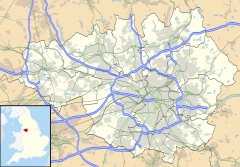Werneth, Greater Manchester facts for kids
Quick facts for kids Werneth |
|
|---|---|
 Booth House is the former headquarters of the Platt Brothers |
|
| Population | 12,348 (Werneth Ward 2011) |
| OS grid reference | SD912043 |
| Metropolitan borough | |
| Metropolitan county | |
| Region | |
| Country | England |
| Sovereign state | United Kingdom |
| Post town | OLDHAM |
| Postcode district | OL8, OL9 |
| Dialling code | 0161 |
| Police | Greater Manchester |
| Fire | Greater Manchester |
| Ambulance | North West |
| EU Parliament | North West England |
| UK Parliament |
|
Werneth is a part of Oldham, a town in Greater Manchester, England. In 2011, about 12,348 people lived here. It's about 1 mile (1.6 km) southwest of Oldham's town centre. Werneth is one of the oldest areas in Oldham. It is next to Westwood, Hollinwood, Hollins, and Chadderton. Werneth also includes an area called Freehold.
In 2017, most of the people living in Werneth (76.6%) were from different ethnic groups. The largest group was people of Pakistani origin (48.6%).
Contents
Discovering Werneth's Past
What Does the Name Werneth Mean?
The name Werneth is very old. It comes from an ancient British word that means "alder tree." Alder trees are a type of tree that grows well in wet places. This name is similar to places in France like Le Vernet.
Werneth Before the Industrial Revolution
In the 1200s, during the time of King Henry III, the area of Oldham was owned by a family called Oldham. They lived at Werneth Hall. Later, the Cudworth family took over as owners of Werneth. A famous person from this family was Ralph Cudworth, who was a chaplain to King James I.
The Cudworth family owned Werneth until 1683. After a few more owners, the Lees family bought the Werneth Hall estate in 1794. In the 1840s, the park around Werneth Hall became a public park, which is now Werneth Park. The old area of Werneth was very large and included parts of what is now Oldham town centre.
Werneth During the Industrial Revolution
Werneth became an important industrial area in the 1800s. It was home to the Platt Brothers factory. This company made machines for spinning cotton, which were used in the many textile mills in Oldham and nearby areas. The Platt Brothers' main office was near the Oldham Werneth railway station, which is now closed.
Because of all the industry, Werneth became a wealthy area. Many large, grand houses were built, especially in a part of Werneth known as Coppice.
Werneth Fire Station (1864–1987)
Werneth had its own fire station for many years. The first fire engine house opened in 1864 on John Street. It cost £932 to build. Police officers worked as part-time firefighters, helped by lamplighters or anyone else available.
In 1898, a new, bigger fire station opened on Manchester Road. It had modern features and special homes for the firefighters and their families. These homes on Frederick Street are still there today. The fire station closed in 1981, and the building was taken down in 1987.
How Werneth is Governed
Werneth has been part of Lancashire since the early 1100s. In 1212, it was one of five areas that belonged to King John. The other areas were Crompton, Glodwick, Oldham, and Sholver. Werneth was part of the larger area of Oldham.
Today, Werneth is an electoral ward within the Metropolitan Borough of Oldham. This means it's a specific area that votes for its local council members. The ward includes Werneth Park, Freehold, Primrose Bank, and parts of Coppice.
Werneth's Geography and Geology
Werneth covers about 100 acres. The ground beneath Werneth has coal, which was mined in the past. Sandstone was also quarried here.
Getting Around Werneth
The Oldham Werneth railway station closed in 2009. The railway line was changed into a tram line for the Manchester Metrolink. Now, the Oldham and Rochdale Line trams serve Werneth. The Westwood and Freehold tram stops offer direct tram links to Manchester and Rochdale Railway Station.
Bus services also connect Werneth to other places. First Greater Manchester operates services 81 and 83, linking Werneth with Oldham and Manchester city centre. Stotts Tours (Oldham) runs bus service 396, which goes to Ashton-U-Lyne and Middleton.
Sports in Werneth
Werneth is home to the Werneth Cricket Club, located at The Coppice on Chamber Road. The club started in 1864. In 1939, Werneth Cricket Club won the Central Lancashire League championship. This was a special win because the league committee awarded them the title after the last games of the season were cancelled due to the start of World War II. This was the only time the club won the league title.
Some famous cricketers have played for Werneth. These include Geoff Pullar, who played for England, and Carl Hooper, a former captain of the West Indies team.
Images for kids








